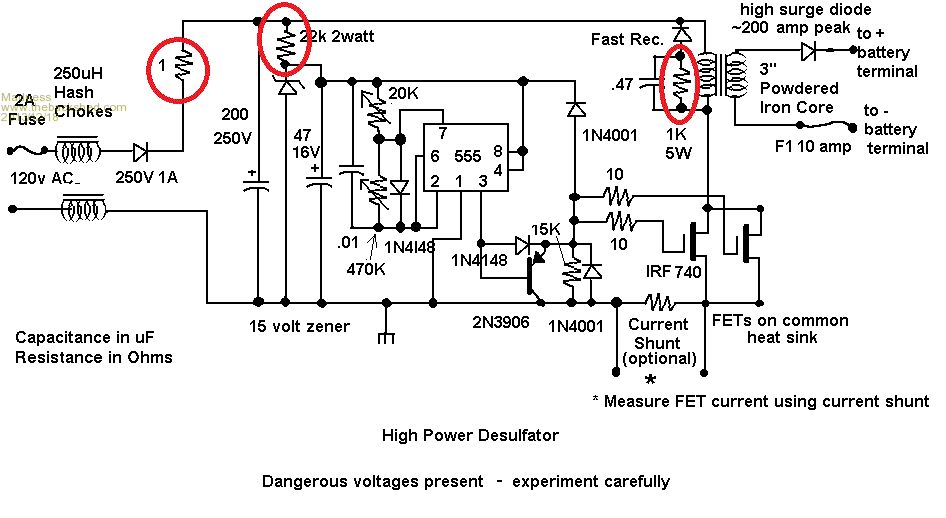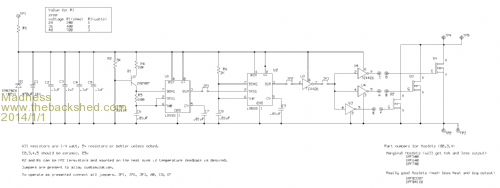
|

|
Forum Index : Electronics : High Power Desulphator build help needed
| Author | Message | ||||
Madness Guru Joined: 08/10/2011 Location: AustraliaPosts: 2498 |
I want to build several high power desulphators to rejuvenate second hand golf cart batteries for my solar power. I have found here plans to build them however it runs off 120 volts AC. Could someone with more than my limited electronics knowledge be able to help please. If I double the value of the resistors circled in red and half the number of turns on the transformer on the charger side, will it work the same as the original circuit but with 240 VAC power? 
There are only 10 types of people in the world: those who understand binary, and those who don't. |
||||
| Gizmo Admin Group Joined: 05/06/2004 Location: AustraliaPosts: 5078 |
Hi Madness In theory, yes, doubling the 2 left hand values might be all thats needed. The other one I don't think matters. But.... I would not build this circuit! Its highly dangerous, even at 120vac. 240vac is just asking to kill someone. Most of the circuit is connected directly to the mains power, and any fault finding or tinkering on your behalf will very easily kill you. Seriously, stay away from this circuit. I've been involved with electronics as a technician/electrician for 30 years and I wouldn't build this circuit simple because I fear a careless moment in testing will kill me. Also the circuit is not well designed. Only using a half wave rectifier on the input is not good practice, especially for a high current application, and there are a few odd component choices. Seriously, don't build this circuit. Glenn The best time to plant a tree was twenty years ago, the second best time is right now. JAQ |
||||
| norcold Guru Joined: 06/02/2011 Location: AustraliaPosts: 670 |
This is only a low power circuit but perhaps it can be altered for your use, has the advantage of using an existing charger thus getting away from the danger. 2013-12-18_230658_Pulse3_web_layout_.pdf We come from the land downunder. Vic |
||||
Madness Guru Joined: 08/10/2011 Location: AustraliaPosts: 2498 |
Thanks for the advice Glenn, Would replacing the dangerous part of the circuit with a DC power supply still work the same, I am wanting to use this on 48 volt battery banks? There are only 10 types of people in the world: those who understand binary, and those who don't. |
||||
| MOBI Guru Joined: 02/12/2012 Location: AustraliaPosts: 819 |
Surely the dangerous voltages problem could be obviated by replacing the AC input with a transformer "plug pack" of suitable size and output volts. Do you have any output transformer data wrt number of turns, wire size etc? If you are desulphating, do you really need high current? I have been using a small unit powered off the battery under desulphation and only after two days operation, the SG has come up from about 1080 to nearly 1200. I previously had the battery on charge without the desulphator for a couple of weeks with no change in the SG of the crook cells. The battery is a FLA type. David M. |
||||
Madness Guru Joined: 08/10/2011 Location: AustraliaPosts: 2498 |
I have read in a number of places that the bigger the bank the more current is needed. I have a couple 24 volt Infinitum Desulphators on order should be here any day. I will see how they go but I have quite few batteries to do and more coming so would like to get a more economical solution. There are only 10 types of people in the world: those who understand binary, and those who don't. |
||||
Madness Guru Joined: 08/10/2011 Location: AustraliaPosts: 2498 |
If any one is looking to build a high power desulphator that will work on batteries up to 48 volt look here. There are only 10 types of people in the world: those who understand binary, and those who don't. |
||||
| Warpspeed Guru Joined: 09/08/2007 Location: AustraliaPosts: 4406 |
I did something like this myself a while back using a one amp plug pack. It will put very fast ten amp pulses into a battery, with about a one amp dc average which is enough to slowly chage a battery, but there are a few design issues you should be aware of. You can charge an inductor up to a genuine ten peak amps of current flow, but you can only do that from a one amp plug pack source if there is a really big electrolytic storage capacitor to draw this very high peak current from. This energy storage inductor needs to have very heavy wire or you will never be able to reach a decent peak current, just due to the dc resistance of the coil. And even if you can, it will run incredibly hot and waste a high proportion of your input power. So you need a really serious high current inductor. The wimpy little coils I see in some of these low cost desulpator kit circuits cannot possibly have the balls to do a decent job of desulphating a big battery. So you charge up your monster coil through some large MOSFETs from an equally monster electrolytic capacitor to some suitably high peak current. And its all good. It then discharges very quickly through a fast diode into the battery at the same current the inductor was originally charged up to. If there is no battery connected, the back EMF voltage from that monster coil is going to hit maybe several thousand volts in just a few tens of nonoseconds. Your power MOSFETs will get spiked right through their tiny little silicon hearts and instantly be destroyed. You can NEVER run one of these independantly powered desulphators without a battery. The battery powered desulphators obviously do not suffer from this problem. No battery, no workie. But an independantly powered desulphator, especially a really powerful one needs to have some built in protection agaist running without a battery. Two ways to do it, or use both ways to be really safe. First way is to get a really big high voltage zener diode and connect it between source and drain right across your MOSFETS. I used a 75 volt 5watt zener on a really large heat sink. Another way is to dump the discharge energy into a faily large high voltage storage capacitor via a diode. Depending on the discharge energy, and the size of the capacitor, the voltage on that capacitor will ratchet up further each time the desulphator fires. You can then sense that voltage and use it to turn off your 555 timer at some safe voltage threshold before the MOSFETs go pop. This will pulse, shut down for a while until the charge on the high voltage capacitor leaks away, then pulse again. On my unit this is about once per second with no battery. The zener idea is safe, simple, and guarantyeed to work. It will generate ferocious heat and self destruct if you leave the desulphator running without a battery load, or if the desulphator wire accidently falls off the battery. The overvoltage shut down idea is better but a bit more complicated. It will run for about a minute on just the zener load, but the zener heatsink will just about be on fire after that. I used both.... Cheers, Tony. |
||||
Madness Guru Joined: 08/10/2011 Location: AustraliaPosts: 2498 |
I have started to build the circuit in the link above, it uses a capacitor bank sitting at about double the battery voltage. Three Mosfets switch the capacitors to the battery at 1 khz for 50 microseconds or something like this. I have got an faulty surround sound amp I am using the case, transformer and heat sink from. The tranny puts out 60 volts, not sure of it's VA rating but it is a fairly big transformer. This setup is supposed to capable of up to 200 amp pulses. 

There are only 10 types of people in the world: those who understand binary, and those who don't. |
||||